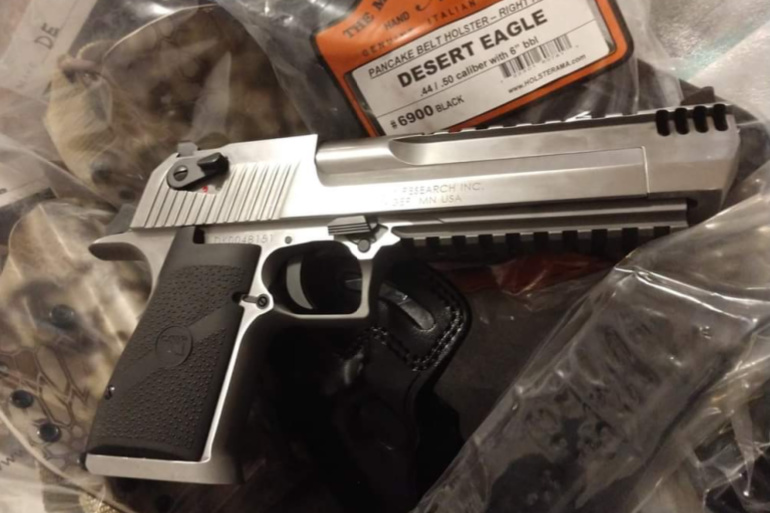
A lot of gun owners tend to think of handguns as either striker-fired or hammer-fired. Of course, there’s more than only those two and some designs are unique in fascinating ways. One standout is the Magnum Research Desert Eagle (and I know what you’re thinking…yes, it’s hammer-fired—but there’s more to it than that).
This big bore pistol is both fun to shoot and has an interesting design. If you, like me, are a gun geek, then you probably also find the Desert Eagle’s operating system worth knowing about. Check out how the Desert Eagle works and why that alone might make it worth having one around (I’m just saying).
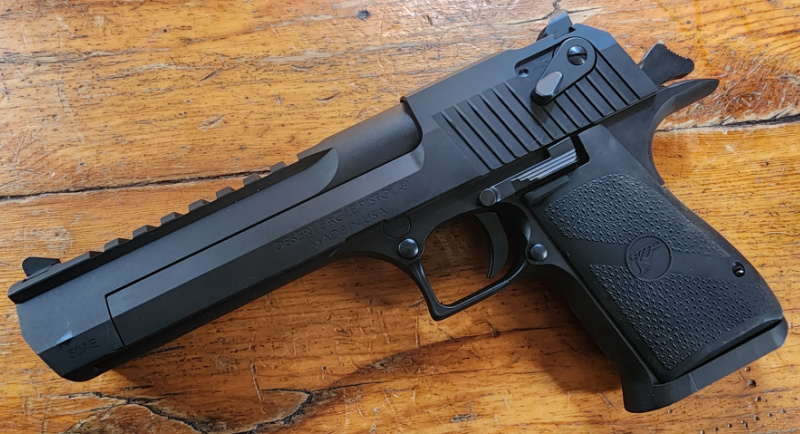
Wait, what’s the Desert Eagle?
The Desert Eagle is one of the most easily recognizable handguns on the market, thanks mostly to movies (think Deadpool, although there are a lot of others). Most people think of the Desert Eagle as a big, blocky, bulky handgun—and they’re not wrong. Its sheer size and iconic outline makes it easy to spot even for those who know little to nothing about guns outside Hollywood special effects.
But despite the fact that it’s often seen as a gimmick, the Magnum Research Desert Eagle was made for a reason. If you’re thinking the gun’s purpose is to be big, you’d be sort of right. The Deagle was designed in the 1980s so big bores like the .44 Magnum could be run in semi-auto handguns. A few guns preceded it, like the Mars Automatic Pistol of the 1890s—and that connection is tenuous as best—and the Auto Mag of 1983.
But even though the Auto Mag had things in common with the Desert Eagle, it didn’t do well. Then there was the Wildey, a futuristic-looking handgun the manufacturer chose to chamber in somewhat oddball rounds like .475 Wildey Magnum. Like the Desert Eagle, the Auto Mag and Wildey were meant to bring magnum chamberings to semi-autos, but they couldn’t quite pull it off (although the Auto Mag is trying to make a comeback).
The Desert Eagle is offered in various calibers including .357 Magnum, .44 Magnum, .429 DE, and .50 AE—the latter of which being the cartridge most people think of. And while some see it as just a novelty, the Desert Eagle definitely has its uses (yes, really).
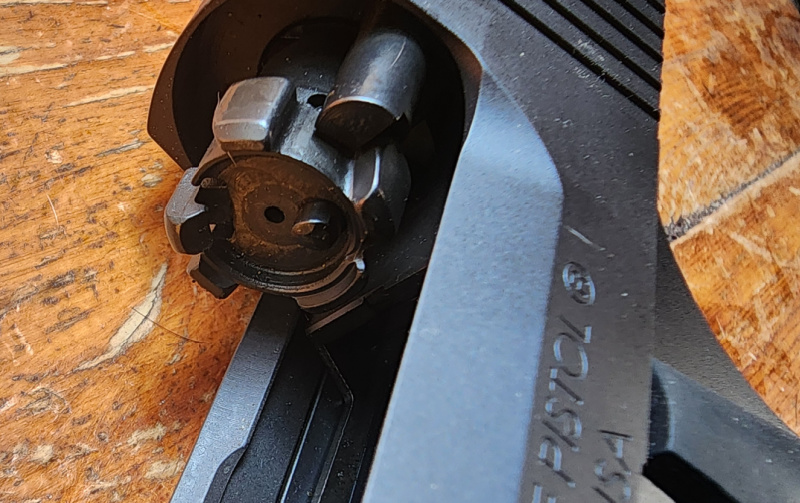
How does the Desert Eagle work?
Now for the fun part. Basically, the Desert Eagle is a gas-operated, rotating bolt, hammer-fired handgun. Of course, it’s also single-action and semi-automatic, so it has not one, but five terms to define it. Makes it sound a little like an AR, doesn’t it?
First, check out the gas system, which shouldn’t be visualized like the block and tube of an AR-15. The Desert Eagle has a gas block? Well yes—but also no. The gun was designed with an integral component some might refer to as an integral gas block, but it isn’t a gas block like you’d find on your AR. On the Desert Eagle, it’s just part of the inner workings of the breech of the handgun and is built into it.
The gas system works courtesy of a gas port that’s also integral—there’s no gas tube—located approximately half an inch in front of the breech. When the gun is fired, gas travels through the port to cycle it. That’s different from the more common short recoil design handguns tend to utilize. The Deagle does it without adding a bunch of moving parts that could become failure points.
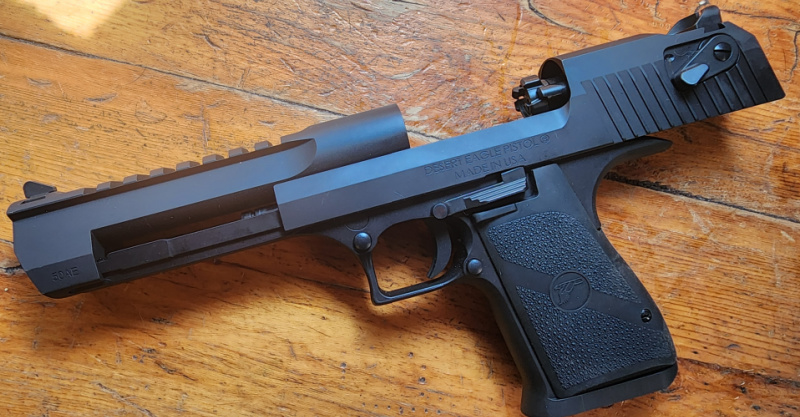
So now that the gun’s been fired, the bullet travels down the barrel. That process pushes gas through the port, moving the piston rearward. Here’s the thing…as cool as the integral gas system is, it’s the component the piston gets moving that’s even better. The escaping gas and moving piston move only the rear portion of the slide backward—the entire slide doesn’t move on a Desert Eagle—and that’s what puts the rotating bolt into motion.
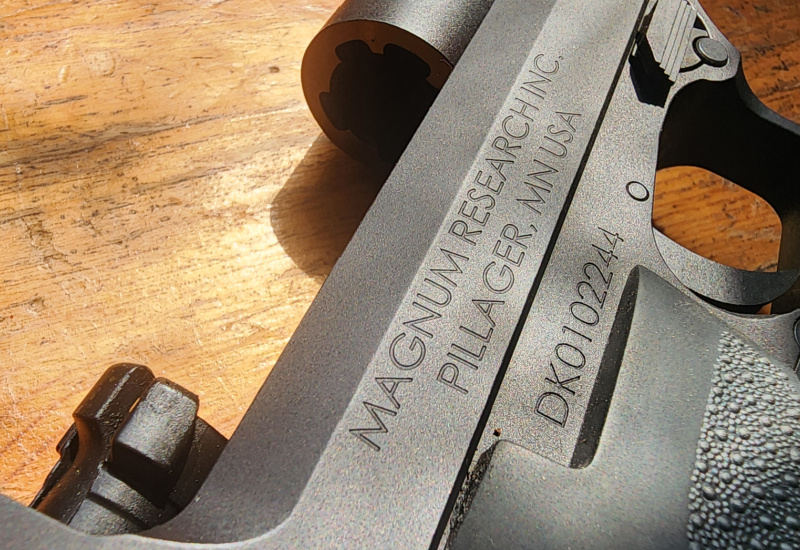
The bolt’s extractor is 1.65-inches in width on the .50 AE (that just happens to be the same size as the 44 Magnum). The rotating bolt of the Desert Eagle moves back—not unlike the way it works in an AR-15, it’s true—taking the spent brass with it so it can be ejected. Then it grabs the next round of ammo and strips it from the magazine into the chamber of the gun.
The rotating bolt is an interesting feature and when you add it to the way only the rear of the slide moves, well, the gun geek in me is pleased. That partial slide movement is possible due to a fixed barrel. Yes, the barrel of the Desert Eagle is mounted to the gun’s frame, so it doesn’t move within the slide.
On to the bolt face of the .50 AE Desert Eagle, which has three locking lugs (the typical AR-15 has seven). There’s a reason for its design, and it mostly has to do with superior durability. The gun must withstand significant amounts of recoil and the escaping gases of .50 AE—the largest semi-auto handgun round currently on the market—and all without being prone to wear and breakage.
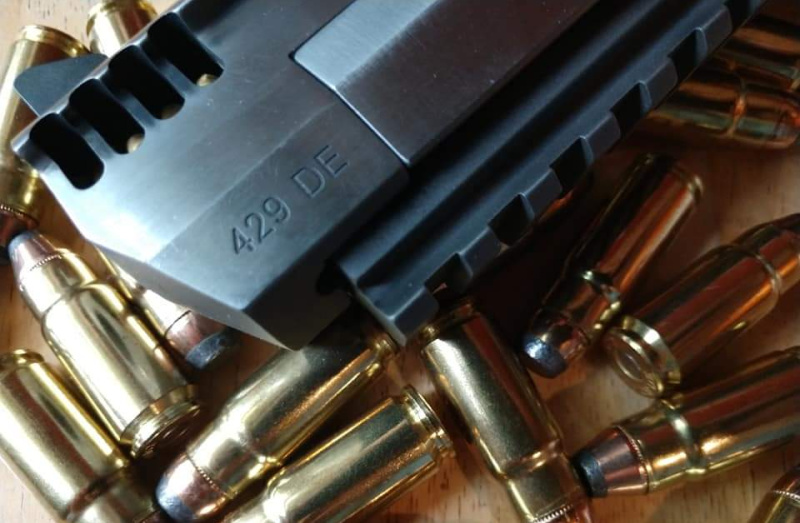
Does the operating system make it accurate?
Sure, the gun’s operating system is unique and rather brilliant, but is the result an accurate gun? A lot of gun owners think a fixed barrel improves accuracy, but the Desert Eagle’s accuracy isn’t really a result of its barrel. The gun’s overall design and the way the details of each component are taken into consideration make it a very good pistol. Without its unique operating system, it couldn’t stand up to the admittedly punishing caliber.
The Deagle is generally an accurate handgun, it’s just not a precise one. It can even be used for hunting (surprise!). I’ve used it to hunt turkey (I don’t really recommend that, it makes enormous holes) deer, and feral hogs. Within around 50 yards you’re good to go, but you’re not getting tight groups. It’s a good idea to add a red dot for greater accuracy and repeatability.
Aside from its sheer size—although it isn’t considered aesthetically pleasing by some—the Desert Eagle boasts an intelligent design. It’s cool—yes, I said cool. It’s engineered correctly to handle fire using very big rounds that generate major amounts of recoil and stress on the gun. It’s made to last, and it’s fun to shoot.
Considering the size of the caliber, I don’t think they could’ve done much better. No, the Desert Eagle isn’t really a practical pistol, and isn’t for everyone, but it’s an interesting, fun gun—and there’s something to be said for fun.

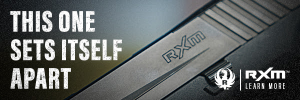
While I would lean more towards the Widley it is always fun to learn new things from unusual guns.
i seem to remember .41mag also.
in .44mag you pretty much want 240 semi jacketed. it comes with a reamer for the gas port, but mines never accumulated any cake.
also worth mentioning is the barrel rifling is polygonal.